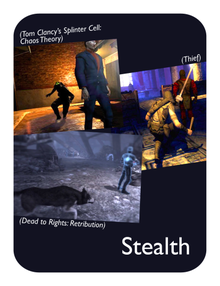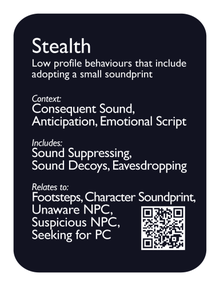Difference between revisions of "Stealth"
ValterAlves (Talk | contribs) m |
ValterAlves (Talk | contribs) m |
||
| (11 intermediate revisions by the same user not shown) | |||
| Line 2: | Line 2: | ||
| name =Stealth | | name =Stealth | ||
| deckversion =1.0 | | deckversion =1.0 | ||
| − | | | + | | v10synopsis =Low profile behaviours that include adopting a small soundprint |
| + | | v20synopsis =Low profile behaviours that include adopting a small soundprint | ||
| patternpresentation = | | patternpresentation = | ||
| cardpresentation= | | cardpresentation= | ||
| − | | | + | | v10frontface =Stealth-front-v10.png |
| − | | | + | | v10backface =Stealth-back-v10.png |
| + | | v20frontface =Stealth-front-v20.png | ||
| + | | v20backface =Stealth-back-v20.png | ||
| screenshots= | | screenshots= | ||
| v10rel-tag1=Context:<br> | | v10rel-tag1=Context:<br> | ||
| Line 24: | Line 27: | ||
| revisions =Introduced in version 1.0 | | revisions =Introduced in version 1.0 | ||
| description = | | description = | ||
| − | Sound plays a special role in [[Stealth]] actions: the sound associated to the PC's actions is relevant for the | + | Sound plays a special role in [[Stealth]] actions: the sound associated to the PC's actions is relevant for the gameplay (that means [[Consequent Sound]]), namely in terms of the reaction of the NPC. Games of the [[Stealth|Stealth ]] genre (or sub-genre) make an extensive use of such explorations. |
Being able to perform [[Stealth]] actions implies that it is possible to adopt a low profile behaviour in order to avoid unwanted attention. That calls for a proper design of the [[Character Soundprint|Character's Soundprint]], which, for instance, depends on the magnitude of the movements. [[Footsteps]], in particular, are usually explored with that purpose. | Being able to perform [[Stealth]] actions implies that it is possible to adopt a low profile behaviour in order to avoid unwanted attention. That calls for a proper design of the [[Character Soundprint|Character's Soundprint]], which, for instance, depends on the magnitude of the movements. [[Footsteps]], in particular, are usually explored with that purpose. | ||
| − | Using modifiers to conceal the sound of the PC's actions ([[Sound Suppressing]]) may also be integrated as part of the | + | Using modifiers to conceal the sound of the PC's actions ([[Sound Suppressing]]) may also be integrated as part of the gameplay. |
Conversely, sound can also be used as tool to overcome opponents. Two examples are the use of [[Sound Decoys]] and [[Eavesdropping]]. | Conversely, sound can also be used as tool to overcome opponents. Two examples are the use of [[Sound Decoys]] and [[Eavesdropping]]. | ||
| Line 37: | Line 40: | ||
| examples= | | examples= | ||
| − | |||
| ex1=<mt p="Stealth" g="Dead To Rights" altg="Dead to Rights: Retribution" w="{{R16by9W}}" h="{{R16by9H}}"></mt> | | ex1=<mt p="Stealth" g="Dead To Rights" altg="Dead to Rights: Retribution" w="{{R16by9W}}" h="{{R16by9H}}"></mt> | ||
| − | | ex2=<mt p="Stealth" g="MGS4" altg="Metal Gear Solid 4" w="{{R16by9W}}" h="{{R16by9H}}"></mt> | + | | ex2=<mt p="Breath" g="Deadly Premonition" w="{{R16by9W}}" h="{{R16by9H}}"></mt> |
| − | | | + | | ex3=<mt p="Stealth" g="MGS4" altg="Metal Gear Solid 4: Guns of the Patriots" w="{{R16by9W}}" h="{{R16by9H}}"></mt> |
| − | | | + | | ex4=<mt p="Stealth" g="Chaos Theory" altg="Tom Clancy's Splinter Cell Chaos Theory" w="{{R5by4W}}" h="{{R5by4H}}"></mt> |
| − | | | + | | ex5=<mt p="Stealth" g="Thief III" altg="Thief III: Deadly Shadows" w="{{R4by3W}}" h="{{R4by3H}}"></mt> |
| − | | | + | | ex6=<mt p="Stealth" g="Papa Sangre" w="{{ViPhoneH}}" h="{{ViPhoneW}}"></mt> |
| + | | ex7=<mt p="Stealth" g="Halo" altg="Halo: Reach" w="{{R16by9W}}" h="{{R16by9H}}"></mt> | ||
| + | |||
| + | | additional= | ||
| + | Stevens, R., & Raybould, D. (2011, p. 122). The game audio tutorial a practical guide to creating and | ||
| + | implementing sound and music for interactive games. Burlington, MA: Focal Press/Elesevier. | ||
}} | }} | ||
Latest revision as of 16:49, 26 August 2012

|

| |
| The card's front face | The card's back face |
Synopsis
| Low profile behaviours that include adopting a small soundprint. |
Relationships
Context:
Consequent Sound ![]() , Anticipation
, Anticipation ![]() , Emotional Script
, Emotional Script ![]() .
.
Includes:
Sound Suppressing ![]() , Sound Decoys
, Sound Decoys ![]() , Eavesdropping
, Eavesdropping ![]() .
.
Relates to:
Footsteps ![]() , Character Soundprint
, Character Soundprint ![]() , Unaware NPC
, Unaware NPC ![]() , Suspicious NPC
, Suspicious NPC ![]() , Seeking for PC
, Seeking for PC ![]() .
.
Description
Sound plays a special role in Stealth actions: the sound associated to the PC's actions is relevant for the gameplay (that means Consequent Sound), namely in terms of the reaction of the NPC. Games of the Stealth genre (or sub-genre) make an extensive use of such explorations.
Being able to perform Stealth actions implies that it is possible to adopt a low profile behaviour in order to avoid unwanted attention. That calls for a proper design of the Character's Soundprint, which, for instance, depends on the magnitude of the movements. Footsteps, in particular, are usually explored with that purpose.
Using modifiers to conceal the sound of the PC's actions (Sound Suppressing) may also be integrated as part of the gameplay.
Conversely, sound can also be used as tool to overcome opponents. Two examples are the use of Sound Decoys and Eavesdropping.
Ways to provide feedback to the player regarding the interest and state of awareness of the NPC towards the PC include designing explorations such as Unaware NPC, Suspicious NPC and Seeking for PC.
The nature of Stealth actions propitiates design opportunities in terms of the Emotional Script, such as the exploration of Anticipation.
Examples
Additional Comments
Stevens, R., & Raybould, D. (2011, p. 122). The game audio tutorial a practical guide to creating and implementing sound and music for interactive games. Burlington, MA: Focal Press/Elesevier.







